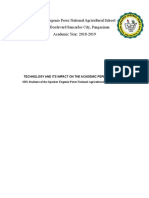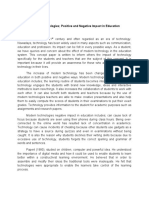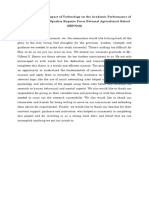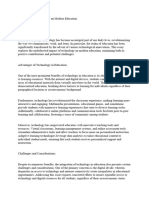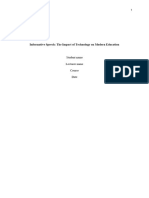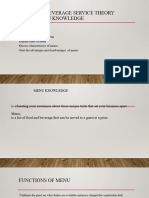Running head: The Impact of Technology on Modern Education 1
The Impact of Technology on Modern Education
Student’s name
Institution affiliation
Date
Author’s name
�The Impact of Technology on Modern Education 2
INTRODUCTION
In the past few years, the incorporation of technology into the curriculum has drastically altered
how individuals learn and educators teach. The introduction of new digital technologies and
online channels has both benefits and drawbacks to modern schooling. This essay will
investigate the positive and bad consequences of technology in the educational setting.
Positive of Technology in Education:
Improved Accessibility for Information: Among the most essential advantages of technology for
education is the ease of access to a wealth of information. The World Wide Web has become a
knowledge treasure mine, enabling learners as well as teachers to delve into a wide range of
topics beyond what conventional textbooks can cover. The accessibility of information allows
students to dive deeper into areas that strike them as intriguing, encouraging a culture of self-
directed learning.
Customized Learning: Technological advancement has enabled customized educational
experiences. Academic applications and software can be tailored according to students' talents
and choices, adjusting content and tempo to meet their specific requirements. This strategy helps
students absorb information effectively by providing focused guidance and challenges, which
improves their general educational achievement.
Collaborative and Relevant Learning: Using technology in the learning environment has
transformed the method in which curriculum is presented. Videos, engaging experiments, and
educational applications are examples of multimedia features that enhance the learning
experience. This innovative and participatory method draws the interest of students, resulting in
increased comprehension and retention of the topic at hand.
Participation and Effective Communication: Technology enables students and instructors to
communicate and collaborate more seamlessly. Online learning environments and internet-based
debates promote active involvement and an awareness of community beyond geographical
boundaries. This improves cooperation abilities and fosters a greater comprehension of different
�The Impact of Technology on Modern Education 3
points of view.
Rapid Evaluation and Response: electronic instruments for assessment simplify the evaluation
process, allowing educators to deliver rapid and comprehensive response to pupils.
Computerized evaluation systems for subjective assessments saves time, allowing instructors to
concentrate on specific instruction requirements and provide focused support as needed.
Negative impact of Technology in Education:
Despite the ubiquitous use of technology, a technological gap exists, resulting in differences in
educational possibilities. Learners from less fortunate households may not have access to reliable
internet access or modern equipment, restricting overall access to online educational tools. This
disparity can worsen educational disparities and impede certain learner’s academic advancement.
Distraction and Data Overload: The prevalence of technology can cause interruptions in
educational settings. Students may be lured to participate in leisure activities on mobile gadgets,
which reduce their concentration on subject matter. Furthermore, the enormous amount of
material available internet may disorient students, rendering it difficult to distinguish trustworthy
sources from disinformation.
Demise of conventional Teaching Methods: An excessive dependence on technology may
result in the loss of useful conventional teaching methods. Face-to-face interactions and hands-
on learning opportunities are critical for developing strong teacher-student relationships and
important social skills. Excessive reliance on digital tools may cause a deterioration in these
critical features of education.
Technological Glitches and Dependence: Technology is not immune to technological flaws
and errors, which can disrupt the learning process. Relying excessively on digital platforms may
render students and instructors impotent in the face of technology problems. Furthermore,
overreliance on technology may impair pupils' ability to adjust to situations in which technology
is not readily available.
�The Impact of Technology on Modern Education 4
Security and confidentiality issues: The incorporation of technology into education creates
issues regarding data privacy and security. Educational institutions must manage sensitive
student information with extreme caution to avoid potential data breaches or illegal access to
personal information.
Finally, technology has undeniably transformed modern schooling, bringing both advantages and
disadvantages. The incorporation of technology has increased access to knowledge, provided
tailored learning experiences, and encouraged interactive and engaging learning. However,
difficulties such as the digital gap, possible diversions, and privacy concerns must be carefully
considered as educators and legislators continue to use technology to improve education.
Striking a balance between exploiting technology's benefits and keeping conventional teaching
techniques is critical for providing a comprehensive and effective educational experience for all
students.
�The Impact of Technology on Modern Education 5
REFERENCES
Bernacki, M. L., Greene, J. A., & Crompton, H. (2020). Mobile technology, learning, and achievement:
Advances in understanding and measuring the role of mobile technology in education. Contemporary
Educational Psychology, 60, 101827.
Naik, G., Chitre, C., Bhalla, M., & Rajan, J. (2020). Impact of use of
technology on student learning outcomes: Evidence from a large-scale
experiment in India. World Development, 127, 104736.
Okoye, K., Hussein, H., Arrona-Palacios, A., Quintero, H. N., Ortega, L. O. P., Sanchez, A. L., ... & Hosseini,
S. (2023). Impact of digital technologies upon teaching and learning in higher education in Latin America:
an outlook on the reach, barriers, and bottlenecks. Education and Information Technologies, 28(2), 2291-
2360.



